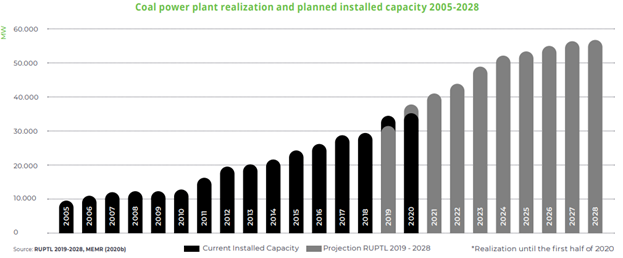Indonesia's Current Progress Towards Green Energy
- Fiolita Nurfitriyana
- Mar 1, 2021
- 4 min read
Updated: May 12, 2023
Untuk membaca artikel ini dalam Bahasa Indonesia, klik di sini
In the Paris Agreement, Indonesia’s Nationally Determined Contribution (NDC) outlines the country’s transition to a low carbon and climate resilience future [1]. Looking from the energy sector, how does the government’s implementation to achieve its NDC’s target to become a low carbon society through green energy?

Source: Mariana Proenca [13]
According to the latest National Electricity Supply Business Plan 2019-2028 (see the figure below), it is estimated that the coal power capacity will grow over the year and will reach 57 GW by 2028, which it means the government still plans to continue with the coal downstream industry development despite the alert of economic risks for this industry [2].
Source: Indonesia Energy Transition Outlook 2021 [14]
However, Indonesia has committed to reduce the greenhouse gas emission by 29% and one of the strategies is to use renewable energy since the ratification of the Paris Agreement [3]. The burning question is: How has this plan progressed, especially during the COVID-19 pandemic?
Renewable Energy: Current Progress
According to the Data Centre and Information of the Ministry of Energy and Mineral Resources Indonesia, the outlook of renewable energy in Indonesia remains positive despite of Covid-19, considering it has increased from 9.2% to 11.51% in mixed energy supply [4]. Not only that, Dadan Kusdiana, Director General of New and Renewable Energy and Energy Conservation, Ministry of Energy and Mineral Resources, stated that there will be increasing investment targets towards the renewable energy sector this year as the result of construction and expansion on renewable power plants [5].
In addition to that, several fossil fuel companies have also shown interests towards renewable energy such as PT. Pertamina, PT. Adaro Energy, PT.MedcoEnergi, etc. but these fossil fuel companies have yet to commit to become carbon-free by 2050.
Nonetheless, some projects have been delayed due to the Covid-19 social restrictions measures.
Geothermal Energy
Due to Covid-19 social restrictions measures, three projects of geothermal energy in 2020 have been put on-hold and will be continued this year. The installed capacity of geothermal energy in Indonesia will be increased from 2,130.7 MW into 2,326.7 MW by 2021. Hendry Tan, CEO of Star Energy Geothermal, stated that Indonesia is one of the countries who has the biggest potential on geothermal energy, which is 24,000 megawatt (MW) [6].
“24,000 MW could lighten around 18.4 millions houses, also could reduce the use of fuels, as well as saving US$ 7.42 billions of Indonesia’s foreign exchange in a year”. – Hendra Tan
Hydropower
Some hydropower projects are going to be conducted this year. PT. PLN runs some hydropower plants projects such as PLTA Pasangan in Aceh, PLTA Asahan 3 in North Sumatra, and PLTA Cisokan in West Java [7].
Solar Power
Solar power continues to grow despite the pandemic, and The government plans to accelerate its development. Arifin Tasrif, Minister of Energy and Mineral Resources Indonesia claimed that the government has prepared the installation of 22,000 solar-powered street lighting, construction of solar photovoltaic (PV) power systems to support ministries/agencies, renewable power plants, and so forth [8].
"To support the agriculture and fishery sectors, we'll build rooftop solar power systems and ground mount power systems to power cold storage" – Arifin Tasrif
Bioenergy
The sources of bio energy can be found in Kalimantan, Sumatera, Irian Jaya, and Sulawesi. The Indonesian government also plans to boost the development of bio energy in order to achieve its 23% target by 2025 [9].
Trois Dilisusendi, Head of Sub-Directorate for the Preparation of the Bioenergy Program of the Directorate General of New Renewable Energy and Energy Conservation, Ministry of Energy and Mineral Resources, claimed that Indonesia has biofuel, biogas, biomass, and probably will mix the use of biomass to Indonesia's power plants in the future. The potential of bio energy in Indonesia is 442 GW but the realization is only 99.4 GW which only met 2% from the target [10].
Wind Energy
Indonesia’s capacity of wind power plants is expected to reach 255 MW by 2025. However, the existing capacity only reached up to 135 MW by last year with 75 MW from Sidrap and 60 MW from Jeneponto region. To identify and choose the location of the project, the availability of potential wind energy map is needed. Last year, Centre for Research and Development of Electricity, New, Renewable Energy, and Energy Conservation Technology updated the map by extending the period of model input and calculating Indonesia’s onshore and offshore wind energy [11].
Program in 2021
As for Directorate General of New Renewable Energy and Energy Conservation sub-sector, Kusdiana explained that there will be several strategic programs to accelerate Indonesia’s shift towards renewable energy in the future:
B30 Mandatory Program, mandatory program to mix 30% of biodiesel with 70% of diesel fuel.
Development of Biomass Co-firing, by using a co-firing method, biomass will be used as the substitution of coal for electric steam power plants.
Increase renewable energy capacity through the development of solar power plants massively.
Converting fossil-fuel basis power plants like Diesel Power Plants – likely produce high amounts of greenhouse gas emissions – with renewable energy basis power plants [12].
In the end, the transition to renewable energy in Indonesia remains positive, but there is no denying that there is a lot of homework for the government to achieve its target.
Visit our forum if you have any questions about green energy!
[4]https://www.beritasatu.com/ekonomi/724071/2021-prospek-investasi-energi-terbarukan-kian-menjanjikan
[7]https://www.cnbcindonesia.com/news/20210204130522-4-221014/begini-cara-pln-dongkrak-energi-terbarukan-ri
[8]https://www.beritasatu.com/ekonomi/724071/2021-prospek-investasi-energi-terbarukan-kian-menjanjikan
Photo(s):



Bình luận